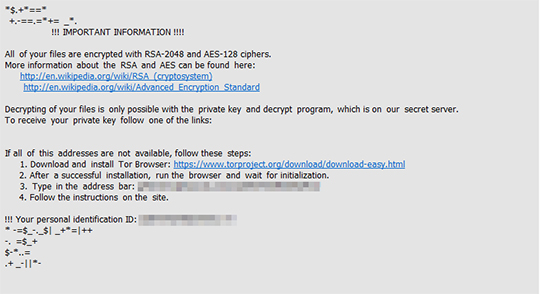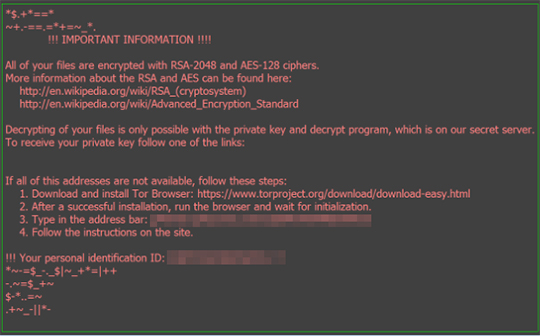RANSOM_LOCKY.DLDTASO
Trojan-Ransom.Win32.Locky.xmi(Kaspersky); Ransom:Win32/Locky(Microsoft)
Windows


Threat Type: Trojan
Destructiveness: No
Encrypted: Yes
In the wild: Yes
OVERVIEW
Dropped by other malware, Downloaded from the Internet
This Trojan arrives on a system as a file dropped by other malware or as a file downloaded unknowingly by users when visiting malicious sites.
It modifies the Internet Explorer Zone Settings.
It connects to certain websites to send and receive information. It deletes itself after execution.
TECHNICAL DETAILS
335,872 bytes
EXE
No
17 Feb 2017
Displays message/message boxes, Connects to URLs/IPs, Encrypts files
Arrival Details
This Trojan arrives on a system as a file dropped by other malware or as a file downloaded unknowingly by users when visiting malicious sites.
Installation
This Trojan drops the following files:
- {Folder containing encrypted files}\OSIRIS-{4 hex characters}.htm
It drops and executes the following files:
- %User Profile%\DesktopOSIRIS.htm ← ransom note
- %User Profile%\DesktopOSIRIS.bmp ← ransom note, also used as the background image
(Note: %User Profile% is the current user's profile folder, which is usually C:\Documents and Settings\{user name} on Windows 2000, XP, and Server 2003, or C:\Users\{user name} on Windows Vista and 7.)
Other System Modifications
This Trojan modifies the following file(s):
- It encrypts files in fixed, removable, RAM disk drives, and network shares.
It modifies the following registry entries:
HKEY_LOCAL_MACHINE\SYSTEM\ControlSet001\
Hardware Profiles\0001\Software\
Microsoft\windows\CurrentVersion\
Internet Settings
ProxyEnable = “1”
(Note: The default value data of the said registry entry is 0.)
It changes the desktop wallpaper by modifying the following registry entries:
HKEY_CURRENT_USER\Control Panel\Desktop
Wallpaper = “%User Profile%\DesktopOSIRIS.bmp”
(Note: The default value data of the said registry entry is {User preference}.)
HKEY_CURRENT_USER\Control Panel\Desktop
TileWallpaper = “0”
(Note: The default value data of the said registry entry is {User preference}.)
HKEY_CURRENT_USER\Control Panel\Desktop
WallpaperStyle = “0”
(Note: The default value data of the said registry entry is {User preference}.)
It sets the system's desktop wallpaper to the following image:
Web Browser Home Page and Search Page Modification
This Trojan modifies the Internet Explorer Zone Settings.
Other Details
This Trojan connects to the following website to send and receive information:
- {BLOCKED}.{BLOCKED}.11.101/checkupdate
- {BLOCKED}.{BLOCKED}.83.189/checkupdate
It encrypts files with the following extensions:
- .001
- .002
- .003
- .004
- .005
- .006
- .007
- .008
- .009
- .01
- .011
- .123
- .602
- .1cd
- .3dm
- .3ds
- .3fr
- .3g2
- .3gp
- .3pr
- .7z
- .7zip
- .aac
- .ab4
- .accdb
- .accde
- .accdr
- .accdt
- .ach
- .acr
- .act
- .adb
- .adp
- .ads
- .aes
- .agdl
- .ai
- .aiff
- .ait
- .al
- .aoi
- .apj
- .apk
- .ARC
- .arw
- .asc
- .asf
- .asm
- .asp
- .aspx
- .asset
- .asx
- .avi
- .awg
- .back
- .backup
- .backupdb
- .bak
- .bank
- .bat
- .bay
- .bdb
- .bgt
- .bik
- .bin
- .bkp
- .blend
- .bmp
- .bpw
- .brd
- .bsa
- .bz2
- .c
- .cdf
- .cdr
- .cdr3
- .cdr4
- .cdr5
- .cdr6
- .cdrw
- .cdx
- .ce1
- .ce2
- .cer
- .cfg
- .cgm
- .cib
- .class
- .cls
- .cmd
- .cmt
- .config
- .contact
- .cpi
- .cpp
- .cr2
- .craw
- .crt
- .crw
- .cs
- .csh
- .csl
- .csr
- .css
- .csv
- .CSV
- .d3dbsp
- .dac
- .das
- .dat
- .db
- .db_journal
- .db3
- .dbf
- .dbx
- .dc2
- .dch
- .dcr
- .dcs
- .ddd
- .ddoc
- .ddrw
- .dds
- .der
- .des
- .design
- .dgc
- .dif
- .dip
- .dit
- .djv
- .djvu
- .dng
- .doc
- .DOC
- .docb
- .docm
- .docx
- .dot
- .DOT
- .dotm
- .dotx
- .drf
- .drw
- .dtd
- .dwg
- .dxb
- .dxf
- .dxg
- .edb
- .eml
- .eps
- .erbsql
- .erf
- .exf
- .fdb
- .ffd
- .fff
- .fh
- .fhd
- .fla
- .flac
- .flf
- .flv
- .flvv
- .forge
- .fpx
- .frm
- .fxg
- .gif
- .gpg
- .gray
- .grey
- .groups
- .gry
- .gz
- .h
- .hbk
- .hdd
- .hpp
- .html
- .hwp
- .ibank
- .ibd
- .ibz
- .idx
- .iif
- .iiq
- .incpas
- .indd
- .iwi
- .jar
- .java
- .jnt
- .jpe
- .jpeg
- .jpg
- .js
- .kc2
- .kdbx
- .kdc
- .key
- .kpdx
- .kwm
- .laccdb
- .lay
- .lay6
- .lbf
- .ldf
- .lit
- .litemod
- .litesql
- .log
- .ltx
- .lua
- .m
- .m2ts
- .m3u
- .m4a
- .m4p
- .m4u
- .m4v
- .mapimail
- .max
- .mbx
- .md
- .mdb
- .mdc
- .mdf
- .mef
- .mfw
- .mid
- .mkv
- .mlb
- .mml
- .mmw
- .mny
- .moneywell
- .mos
- .mov
- .mp3
- .mp4
- .mpeg
- .mpg
- .mrw
- .ms11
- .ms11 (Security copy)
- .msg
- .myd
- .MYD
- .MYI
- .n64
- .nd
- .ndd
- .ndf
- .nef
- .NEF
- .nk2
- .nop
- .nrw
- .ns2
- .ns3
- .ns4
- .nsd
- .nsf
- .nsg
- .nsh
- .nvram
- .nwb
- .nx2
- .nxl
- .nyf
- .oab
- .obj
- .odb
- .odc
- .odf
- .odg
- .odm
- .odp
- .ods
- .odt
- .ogg
- .oil
- .onetoc2
- .orf
- .ost
- .otg
- .oth
- .otp
- .ots
- .ott
- .p12
- .p7b
- .p7c
- .pab
- .pages
- .PAQ
- .pas
- .pat
- .pcd
- .pct
- .pdb
- .pdd
- .pef
- .pem
- .pfx
- .php
- .pif
- .pl
- .plc
- .plus_muhd
- .png
- .pot
- .potm
- .potx
- .ppam
- .pps
- .ppsm
- .ppsx
- .ppt
- .PPT
- .pptm
- .pptx
- .prf
- .ps
- .psafe3
- .psd
- .pspimage
- .pst
- .ptx
- .pwm
- .py
- .qba
- .qbb
- .qbm
- .qbr
- .qbw
- .qbx
- .qby
- .qcow
- .qcow2
- .qed
- .r3d
- .raf
- .rar
- .rat
- .raw
- .rb
- .rdb
- .re4
- .rm
- .rtf
- .RTF
- .rvt
- .rw2
- .rwl
- .rwz
- .s3db
- .safe
- .sas7bdat
- .sav
- .save
- .say
- .sch
- .sd0
- .sda
- .sdf
- .sh
- .sldm
- .sldx
- .slk
- .sql
- .sqlite
- .sqlite3
- .SQLITE3
- .sqlitedb
- .SQLITEDB
- .sr2
- .srf
- .srt
- .srw
- .st4
- .st5
- .st6
- .st7
- .st8
- .stc
- .std
- .sti
- .stm
- .stw
- .stx
- .svg
- .swf
- .sxc
- .sxd
- .sxg
- .sxi
- .sxm
- .sxw
- .tar
- .tar
- .tbk
- .tex
- .tga
- .tgz
- .thm
- .tif
- .tiff
- .tlg
- .txt
- .uop
- .uot
- .upk
- .vb
- .vbox
- .vbs
- .vdi
- .vhd
- .vhdx
- .vmdk
- .vmsd
- .vmx
- .vmxf
- .vob
- .wab
- .wad
- .wallet
- .wav
- .wb2
- .wk1
- .wks
- .wma
- .wmv
- .wpd
- .wps
- .x11
- .x3f
- .xis
- .xla
- .xlam
- .xlc
- .xlk
- .xlm
- .xlr
- .xls
- .XLS
- .xlsb
- .xlsm
- .xlsx
- .xlt
- .xltm
- .xltx
- .xlw
- .xml
- .ycbcra
- .yuv
- .zip
- wallet.dat
It renames encrypted files using the following names:
- {first 8 characters of ID}--{next 4 characters of ID}--{last 4 characters of ID}--{8 hex characters}--{12 hex characters}.osiris
It does the following:
- It prevents encrypting files containing any of the following strings in its full path name:
- @_HELP_instructions.html
- _HELP_instructions.bmp
- _HELP_instructions.txt
- _Locky_recover_instructions.bmp
- _Locky_recover_instructions.txt
- tmp
- winnt
- Application Data
- AppData
- Program Files (x86)
- Program Files
- temp
- thumbs.db
- $Recycle.Bin
- System Volume Information
- Windows
- It deletes shadow copies by executing following command:
- vssadmin.exe Delete Shadows /Quiet /All
It deletes itself after execution.
NOTES:
The ransomware opens the dropped %User Profile%\DesktopOSIRIS.htm which contains the ransom note.

It also opens the dropped %User Profile%\DesktopOSIRIS.bmp which is also the desktop wallpaper that contains the ransom note.
SOLUTION
9.850
13.226.04
17 Feb 2017
13.227.00
18 Feb 2017
Step 1
Before doing any scans, Windows XP, Windows Vista, and Windows 7 users must disable System Restore to allow full scanning of their computers.
Step 2
Note that not all files, folders, and registry keys and entries are installed on your computer during this malware's/spyware's/grayware's execution. This may be due to incomplete installation or other operating system conditions. If you do not find the same files/folders/registry information, please proceed to the next step.
Step 3
Restart in Safe Mode
Step 4
Search and delete this file
- %User Profile%\DesktopOSIRIS.htm
- %User Profile%\DesktopOSIRIS.bmp
- {Folder containing encrypted files}\OSIRIS-{4 hex characters}.htm
Step 5
Restore this modified registry value
Important: Editing the Windows Registry incorrectly can lead to irreversible system malfunction. Please do this step only if you know how or you can ask assistance from your system administrator. Else, check this Microsoft article first before modifying your computer's registry.
- In HKEY_LOCAL_MACHINE\SYSTEM\ControlSet001\Hardware Profiles\0001\Software\Microsoft\windows\CurrentVersion\Internet Settings
- ProxyEnable = “1”
- ProxyEnable = “1”
Step 6
Reset your Desktop properties
Step 7
Reset Internet security settings
Step 8
Restart in normal mode and scan your computer with your Trend Micro product for files detected as RANSOM_LOCKY.DLDTASO. If the detected files have already been cleaned, deleted, or quarantined by your Trend Micro product, no further step is required. You may opt to simply delete the quarantined files. Please check this Knowledge Base page for more information.
Step 9
Restore encrypted files from backup.
Did this description help? Tell us how we did.


